
Åstorp is a bimunicipal locality and the seat of Åstorp Municipality in Scania County, Sweden with 9,488 inhabitants in 2010. It is also partly located in Ängelholm Municipality.

The Proastiakos is Greece's Commuter rail service, run by Hellenic Train, on rail infrastructure owned by the Hellenic Railways Organisation (OSE) (lines) and GAIAOSE. These services connect a participating city's central railway station to important locations such as a city's port or airport, as well as its suburbs and occasionally nearby towns and cities.
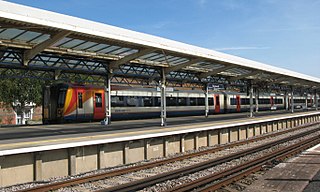
Weymouth is the main railway station serving the town of Weymouth, in Dorset, England; the other is at Upwey, which is located north of the town centre. It is the southern terminus of both the South West Main Line, 142 miles 64 chains (229.8 km) down the line from London Waterloo, and the Heart of Wessex Line from Bristol Temple Meads and Gloucester, 168 miles 63 chains (271.6 km) from London Paddington.

Pågatågen is an interurban commuter and regional railway system in Skåne County, Sweden, and is owned by Skånetrafiken, the regional public transportation authority. The trains are operated by the contractor VR Sverige. The network has 72 stations, of which 9 are in the Malmö Urban Area: Malmö C, Triangeln, Hyllie, Svågertorp, Persborg, Rosengård, Östervärn, Burlöv and Oxie and 6 in the Helsingborg Urban Area: Helsingborg C, Maria, Påarp, Ramlösa, Rydebäck and Ödåkra.

Geneva railway station, also known as Geneva Cornavin railway station, is Geneva's main train station, located in the centre of the city. The immediate area surrounding it is known as Cornavin; both names can be used interchangeably.

Würzburg Hauptbahnhof is a railway station for the city of Würzburg in the German state of Bavaria. It was opened in 1864 to the north of the inner city as a replacement for the former Ludwigsbahnhof in the city centre, the capacity of which had been exhausted by the dramatic increase of rail traffic. Even today, Würzburg station is one of the major stations in Bavaria, since it lies at the intersection of several heavily used rail corridors. In particular, the routes in the north–south direction from Hamburg and Bremen to Munich as well as in west–east direction from the Rhine-Ruhr and Rhine-Main to Nuremberg and Vienna. Apart from Aschaffenburg Hauptbahnhof, Würzburg is the only station in Lower Franconia to be served by Intercity-Express services. With its combination of rail, tram and bus services, the station is the main hub for public transport in the city and the district of Würzburg.
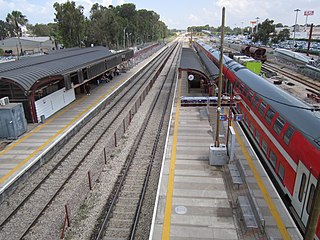
Netanya railway station is an Israel Railways passenger station located in the city of Netanya and serves the city, with its large North industrial zone, as well as other small communities in the area.

Copenhagen Airport railway station is a railway station in Tårnby, Denmark, serving Copenhagen Airport. It is located below ground directly under the check-in and arrival area in the airport's Terminal 3.
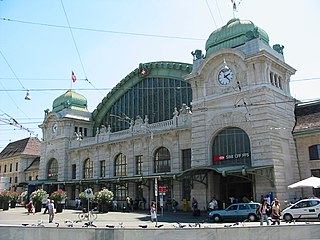
Basel SBB railway station is the central railway station in the city of Basel, Switzerland. Opened in 1854, and completely rebuilt in 1900–1907, it is Europe's busiest international border station. Basel SBB is owned by the Swiss Federal Railways (SBB CFF FFS). The other major railway station is Basel Badischer Bahnhof, operated by the German railway company Deutsche Bahn, on the north side of the Rhine from the city centre.
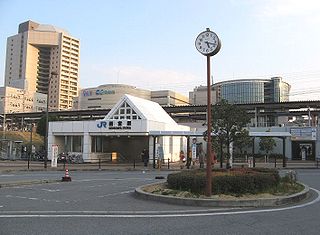
Nishinomiya Station is a passenger railway station located in the city of Nishinomiya, Hyōgo Prefecture, Japan. It is operated by the West Japan Railway Company. As a part of the JR West Urban Network, the following cards are accepted: J-Thru Card, ICOCA, Suica, Pasmo, and PiTaPa.

Skånetrafiken is the regional public transit district in Skåne län, in the south of Sweden.

Malmö Central Station is the main railway station serving the city of Malmö, Sweden. It is located in central Malmö, situated between the historic city centre and the Port of Malmö. Opened on the Southern Main Line in 1856, it serves approximately 17 million passengers per year.

Zurich Airport railway station is a railway station serving Zurich Airport in Switzerland. The station is located underneath the Airport Centre, the main ground-side passenger terminal of the airport, which is in the canton of Zurich and the municipality of Kloten.
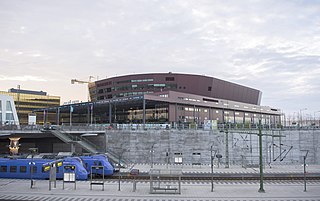
Hyllie Station is a railway station located in the Hyllie city district in the southwestern part of Malmö, Sweden. It is the final station on the Swedish side of the Öresund Line before trains pass the Öresund Bridge towards Denmark.

The HH Tunnel is a proposed series of tunnels under Øresund between Helsingborg in Sweden and Helsingør in Denmark. The connection is planned for passenger trains, and other proposals for the tunnels include freight rail and road tunnels.

Münster-Hiltrup station is a suburban station in the district of Münster-Hiltrup in the city of Münster in the German state of North Rhine-Westphalia. It is served by regional trains between Munster and Hamm and is an important station for commuters and students. The station is conveniently located between central Hiltrup and Hiltrup Ost. In addition, the station is served by several city bus lines.

Stadtallendorf station is a through station at the 82.1 km mark of the Main-Weser Railway in the town of Stadtallendorf in the German state of Hesse. The station is classified by Deutsche Bahn (DB) as a category 4 station. The platforms, underpass and the area around the station were modernised and redecorated in preparation for the Hessentag celebrations of 2010.

Helsingør station is the principal railway station serving the city of Helsingør in North Zealand, Denmark. It is located in the centre of the town, close to the Port of Helsingør, and immediately adjacent to the Helsingør ferry terminal and the Helsingør bus terminal.

Helsingborg Central Station or 'Helsingborg C', also colloquially known as Knutpunkten is the primary railway station in Helsingborg. It is a transit hub for ferries, long-distance trains (SJ), Öresundståg, Pågatåg, city- and regional buses. It is one of Sweden's busiest transit hub facilities.
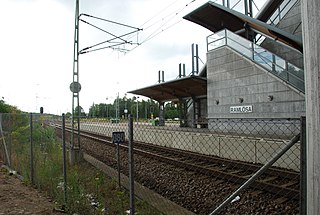
Ramlösa Station is a railway station in the Ramlösa district of Helsingborg in Sweden. The station was inaugurated in its current form in 1865 and mainly serves commuter trains Pågatågen. On the Hästhag Viaduct above, the station is connected to both city buses and regional buses. Internally for traffic management the station is called Helsingborg godsbangård (Hbgb), the only station in Sweden with a totally different name between traffic management and towards passengers.




















